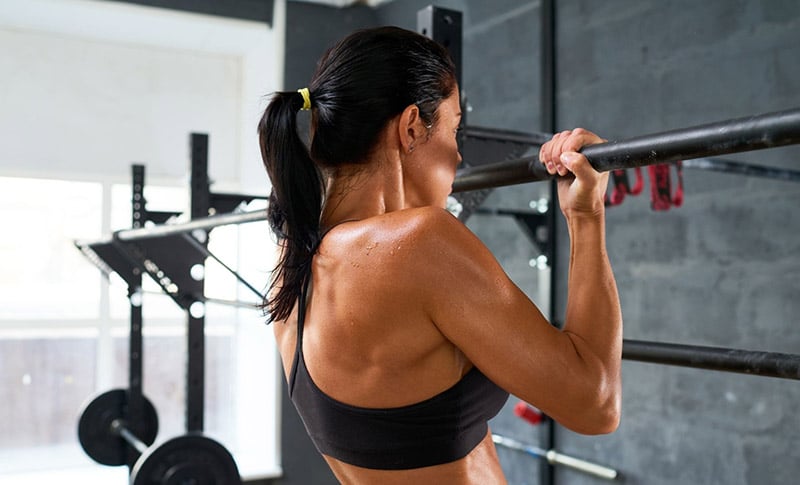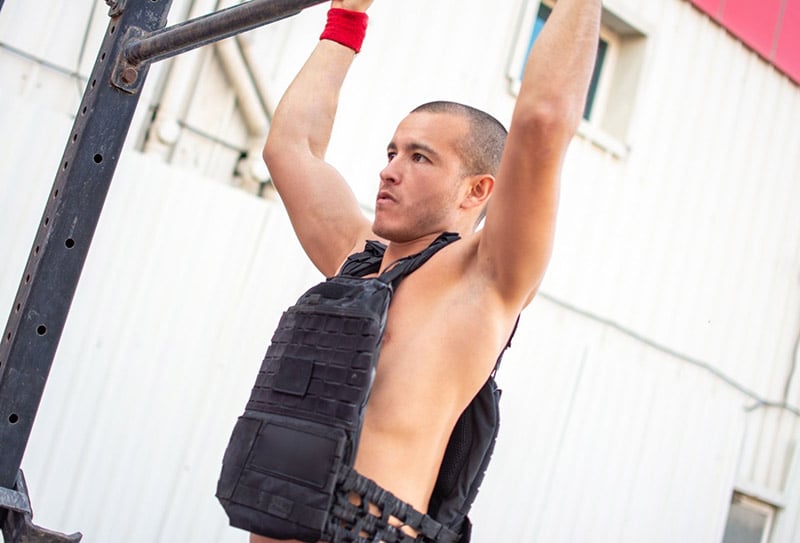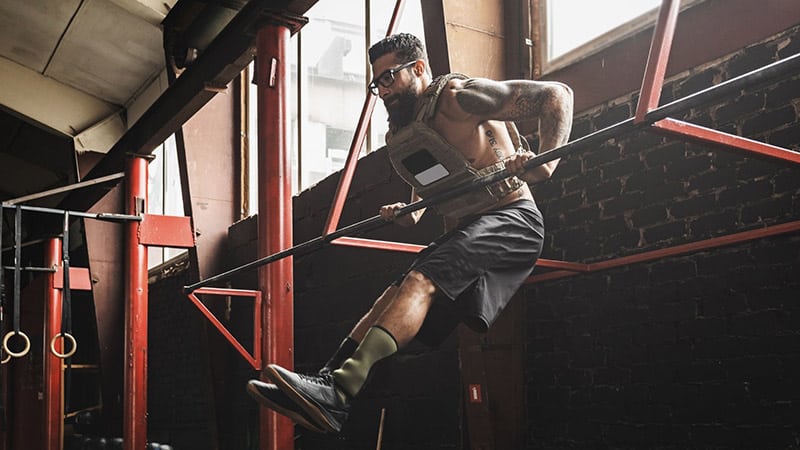La traction en musculation est un excellent exercice pour muscler le haut du corps. Toutefois, il s’agit d’un mouvement qui peut être difficile à appréhender, notamment si vous êtes débutant. Nombre de pratiquants le laissent de côté, alors que ses bénéfices sont nombreux.
Dans cet article, je vous révèle les clés pour apprendre à faire votre première traction, puis pour progresser durablement.
Progresser aux tractions, en bref :
- Les tractions sont un exercice complet pour muscler le haut du corps.
- Elles sollicitent principalement le dos, les bras et améliorent la force.
- Il existe plusieurs variantes de tractions pour cibler différents muscles.
- Les débutants peuvent utiliser des tractions assistées ou négatives.
- Un bon grip est essentiel pour progresser aux tractions.
- Pratiquer régulièrement permet d’augmenter le nombre de répétitions.
- Ajouter du lest est une méthode efficace pour progresser.
Sommaire
Qu’est-ce qu’une traction en musculation ?
La traction est sans nul doute l’un des meilleurs mouvements de musculation pour sculpter le haut du corps. Elle permet principalement de travailler les muscles du dos et des bras.
Le but de l’exercice est de soulever le poids de son corps en se tirant vers le haut, à l’aide des bras et des dorsaux.
Globalement, le mouvement de traction est porteur de nombreux bienfaits :
- Il s’agit d’un exercice complet, qui sollicite de nombreux muscles.
- Il contribue au bon développement de la musculature de base, ce qui est indispensable pour enchaîner des mouvements plus avancés (front lever, muscle-up).
- Il permet également de gagner en force.
- Il participe à l’amélioration de la poigne.
Pour autant, faut-il faire des tractions tous les jours ?
Quel que soit votre objectif, un tel rythme n’est pas forcément recommandé. En effet, comme pour tout exercice de musculation, il est préférable de prévoir des temps de récupération suffisants entre vos entraînements d’un même groupe musculaire.
De cette manière, vous mettrez toutes les chances de votre côté pour améliorer votre performance la fois suivante.
Les différents types de tractions
Si la traction pronation est la version la plus courante, il existe en réalité différentes variantes de tractions que je vous propose de découvrir.
Ces dernières permettent de diversifier les entraînements selon les groupes musculaires sollicités.
La traction pronation (pull-up)
La traction en prise pronation est la version de base de cet exercice.
Pour faire des pull-ups, vos paumes de main doivent simplement être tournées vers l’avant. Ce type de traction favorise le travail des dorsaux.
La traction supination (chin-up)
Connue sous le nom de chin-up, cette autre variante consiste à saisir la barre de traction avec les paumes de main vers vous.
En plus des muscles dorsaux, ce mouvement cible prioritairement les biceps.

La traction prise large
Cette variante de traction vise à ce que l’espace entre vos mains soit supérieur à la largeur de vos épaules.
Les tractions en prise large sont idéales pour obtenir une silhouette en V et développer la largeur de votre dos.
La traction prise serrée
À l’inverse des tractions prise large, le positionnement des mains sur les tractions prise serrée est inférieur à la largeur des épaules.
Réalisable sur une barre de traction classique ou sur des barres parallèles en prise neutre, cet exercice permet de développer l’épaisseur du dos.

DÉCOUVREZ TOUS MES PROGRAMMES
Téléchargez mon application MetamorphX et commencez votre transformation physique dès aujourd’hui !
La traction prise mixte
Pour exécuter ce type de traction, l’une de vos mains doit être en pronation, l’autre en supination.
Inspirée du soulevé de terre, cette prise hybride améliore votre grip.
La traction assistée
Les tractions assistées sont plutôt destinées aux débutants en musculation souhaitant progresser.
Elles peuvent être réalisées sur une machine à traction dédiée à la salle de sport, ou à l’aide d’une bande élastique.

La traction lestée
À l’inverse, les tractions lestées s’adressent aux personnes ayant déjà un certain niveau en matière de tractions.
En plus de votre poids de corps, ajoutez simplement du poids sur vous (gilet lesté, ceinture de lest, etc.) pour faire ce type de tractions.
Encore une fois, cet exercice est réservé aux athlètes expérimentés.

Le muscle up
Le muscle up combine deux mouvements de musculation : les tractions et les dips. L’objectif est de faire une traction, puis de vous soulever jusqu’à ce que vos bras soient tendus au-dessus de la barre.
Très utilisé en cross-training et en street workout, il s’agit d’un exercice difficile mais efficace.

La traction à un bras
Les tractions à un bras sont sans nul doute les plus difficiles.
Elles nécessitent beaucoup de force pour pouvoir soulever votre poids avec une seule main sur la barre.
La traction australienne (ou traction inversée)
Pour faire des tractions australiennes, vous devrez vous placer sous une barre, le corps à l’horizontale et les talons contre le sol.
Quels sont les muscles sollicités par les tractions ?
Regardons maintenant quels muscles travaillent les tractions.
Vous l’avez compris, plusieurs groupes musculaires sont ciblés : les biceps, les triceps, les trapèzes, les deltoïdes, les dorsaux, le torse et les abdominaux.
En ce sens, les tractions sont considérées comme exercice de base (ou polyarticulaire).
Malgré le fait que les tractions aident à développer tout le haut du corps, elles peuvent rester difficiles à exécuter. En effet, elles impliquent d’avoir un minimum de force dans les bras pour pouvoir être réalisées correctement.
Pour vous aider dans cette entreprise, voyons ensemble comment s’entraîner pour faire des tractions.
Comment réussir à faire sa première traction ?
Si vous ne parvenez pas à faire les tractions correctement, voici la marche à suivre.
La première étape consiste, si vous êtes en situation de surpoids, à essayer de perdre quelques kilos de gras. Plus votre physique sera sec, plus il sera facile de vous tracter en haut de la barre.
Découvrez dans cet article comment faire une sèche efficace en 7 étapes.
Ensuite, vous devrez renforcer votre dos, vos bras et vos épaules. L’objectif est de gagner en force pour pouvoir progresser aux tractions. Pour cela, voici quelques exercices à ajouter à votre routine :
- Les tractions inversées
- Le tirage vertical
- Le tirage horizontal (n’hésitez pas à varier les prises)
- Le rowing buste penché
- Le développé militaire
- Le curl biceps
Réussir une traction est aussi une question de prise. Vous pouvez l’améliorer en intégrant des exercices tels que le soulevé de terre ou le farmer walk dans votre programme d’entraînement. Vous pouvez également vous entraîner en restant plusieurs secondes suspendu à une barre de traction.
Une fois ce renforcement musculaire effectué, commencez un travail spécifique pour les tractions. Au début, vous pourrez utiliser une machine à traction guidée, si votre salle de fitness en est équipée.
Mais l’idéal est de faire des tractions à la barre fixe en utilisant un élastique pour vous assister. Cela vous permettra de réduire le poids du corps à soulever. Le principe est simple : vous attachez la bande élastique sur la barre, attrapez cette dernière et déplacez vos tibias ou pieds sur la bande. Grâce à cette technique, vous pourrez vous hisser pour faire vos tractions.
En parallèle, je vous recommande de faire des tractions négatives ou excentriques. Ces dernières consistent à sauter sur la barre pour se mettre en position finale, le menton au-dessus de la barre (vous pouvez aussi utiliser un step ou une jump box pour monter).
Descendez ensuite le plus lentement possible, au moins sur 5 secondes, pour revenir en position de départ, bras tendus, comme vous pouvez le voir dans la vidéo ci-dessous.
Effectuez ce travail de tractions 2 à 3 fois par semaine. En adoptant un programme traction spécifique, vous parviendrez à améliorer votre technique et à progresser concrètement en quelques semaines.
Comment progresser en traction ?
Nous y sommes ! Félicitations, vous avez réussi à faire vos premières tractions.
Au bout d’un certain temps, il est logique que vous stagniez et que vous ne parveniez plus à augmenter votre nombre de répétitions.
Là encore, en adoptant un entraînement aux tractions spécifique, vous n’aurez aucun mal à débloquer ce plateau.
Ce travail n’est d’ailleurs pas bien différent de celui à mettre en place pour un débutant.
Pour progresser, faites des tractions plusieurs fois par semaine. Vous pouvez, par exemple, conclure chacune de vos séances à la salle de musculation par 2 ou 3 séries au poids du corps.
Continuez aussi à faire des tractions excentriques.
Enfin, l’ajout de poids, via un gilet ou une ceinture lestée, est aussi un excellent moyen d’augmenter votre nombre de répétitions.
Conclusion
Vous savez désormais comment faire des tractions et comment vous entraîner pour progresser. Quel que soit votre objectif, cet exercice est idéal pour développer la musculature du haut du corps.
Au poids du corps ou avec du lest, n’hésitez pas à en faire un mouvement de base de votre programme d’entraînement.
FAQ
Les tractions sollicitent principalement le dos (dorsaux, trapèzes), les bras (biceps, triceps) et les épaules (deltoïdes). Elles renforcent aussi la poigne et le gainage.
Perdez du poids si nécessaire, renforcez vos bras et votre dos avec des exercices comme le tirage vertical et les tractions assistées. Travaillez aussi votre grip et pratiquez les tractions négatives.
2 à 3 séances par semaine sont idéales. Laissez un jour de repos entre chaque entraînement pour favoriser la récupération et éviter les blessures.
Non, le surentraînement peut ralentir la progression. Il est important d’alterner avec des jours de repos ou des entraînements variés.
Augmentez progressivement le nombre de répétitions, ajoutez du lest et variez les prises. Travaillez aussi les tractions excentriques pour gagner en force.
Oui, elles sont un excellent exercice polyarticulaire qui favorise la prise de masse musculaire, surtout si vous augmentez l’intensité avec du lest.
Le tirage vertical, le tirage horizontal et le rowing buste penché sont de bonnes alternatives pour renforcer les mêmes groupes musculaires.





